Abstract
In this paper, it is demonstrated that the AlGaN high electron mobility transistor (HEMT) based on silicon wafer exhibits excellent high-temperature performance. First, the output characteristics show that the ratio of on-resistance (RON) only reaches 1.55 when the working temperature increases from 25 °C to 150 °C. This increase in RON is caused by a reduction in optical phonon scattering-limited mobility (μOP) in the AlGaN material. Moreover, the device also displays great high-performance stability in that the variation of the threshold voltage (ΔVTH) is only 0.1 V, and the off-state leakage current (ID,off-state) is simply increased from 2.87 × 10−5 to 1.85 × 10−4 mA/mm, under the operating temperature variation from 25 °C to 200 °C. It is found that the two trap states are induced at high temperatures, and the trap state densities (DT) of 4.09 × 1012~5.95 × 1012 and 7.58 × 1012~1.53 × 1013 cm−2 eV−1 are located at ET in a range of 0.46~0.48 eV and 0.57~0.61 eV, respectively, which lead to the slight performance degeneration of AlGaN HEMT. Therefore, this work provides experimental and theoretical evidence of AlGaN HEMT for high-temperature applications, pushing the development of ultra-wide gap semiconductors greatly.
1. Introduction
Owing to the high electric field strength and electron mobility of the GaN material, GaN HEMTs have been widely researched and applied in power electronics [1,2,3,4,5]. Compared with traditional GaN materials, ultra-wide bandgap (UWBD) materials possess higher bandgaps and critical electric fields; thus, these devices based on UWBD materials have more developmental potential in power electronic applications [6,7,8,9,10,11]. Among these UWBD materials (β-Ga2O3, diamond, and AlN), the material growth and device fabrication of AlGaN appear to be much easier due to the relevant GaN-based heterojunction. Moreover, AlGaN HEMTs have been recognized as an excellent candidate for high-temperature applications because of their great thermal stability [12,13]. The outstanding performance of AlGaN HEMTs under extreme temperature conditions makes them an ideal choice for a wide range of applications, including aerospace, electric vehicles, radar and communication, energy conversion, and industrial automation.
For these reasons, many scholars have carried out extensive studies on the device characteristics of AlGaN HEMTs at high temperatures. Numerous valuable achievements have been obtained, including lower drain current attenuation, off-state leakage current, on-resistance degradation, channel mobility attenuation, smaller threshold voltage shift, higher breakdown electric field, saturated drain current, and current gain cut-off frequency of AlGaN channel HEMTs compared with traditional GaN channel HEMTs [14,15,16,17,18,19,20,21,22,23,24,25]. However, most of these reports are based on sapphire and AlN substrates, and there is a lack of research on the performance and related analysis of the AlGaN HEMTs based on silicon (Si-based AlGaN HEMTs) at high temperatures. As is known, the Si-based AlGaN HEMTs have better thermal conductivity and greater commercialization potential due to the use of low-cost substrates. Therefore, it is necessary to investigate the high-temperature characteristics of Si-based AlGaN HEMTs and identify the relevant influence factors for performance degeneration so as to put forward more useful strategies to solve it.
In this work, the technology of pulsed metal–organic chemical vapor deposition (MOCVD) was used to fabricate the 6-inch AlGaN wafer on the Si substrate. Then, the Si-based AlGaN HEMT with 400 nm Al0.1Ga0.9N as a channel layer was fabricated and showed a low contact resistance of 0.95 Ω·mm and a high breakdown voltage of 1110 V (with LGD = 15 μm). In addition, the output and transfer characteristics of this device at high-temperature working conditions were systematically investigated. Using the alternating current conductance method, the trapping effect in the AlGaN channel was characterized by time constants (τT) and DT, which helped to explain the performance degradation. Overall, given the cost advantages of Si-based AlGaN HEMTs, this study provides valuable references for future design optimizations of such devices and also lays the theoretical foundation for their practical applications in harsh environments, such as those involving high temperatures and high powers.
2. Materials and Methods
The pulsed MOCVD system was used to grow AlGaN material on a 6-inch Si substrate. Firstly, an AlN nucleation layer was deposited. Then, a 3 μm graded AlxGa1−xN layer, 1 μm C-doped Al0.1Ga0.9N layer, 400 nm Al0.1Ga0.9N channel layer, 1 nm AlN insertion layer, 24 nm Al0.4Ga0.6N barrier layer, and 2 nm GaN cap layer were grown above the AlN nucleation layer as a sequence. The HRXRD rocking curves from (0002) and (10–12) planes of the AlGaN channel layer in this work are 708 and 1147 arcsec, respectively.
The fabrication process of AlGaN HEMTs began with mesa isolation etching. Thereafter, a 30 nm recess was etched accurately using the inductively coupled plasma (ICP) technique, and the Ti/Al alloy was deposited and annealed to form ohmic contact as a source/drain electrode. The Ni/Al alloy was deposited as a gate electrode. Finally, 40 nm Al2O3 was grown on the surface of AlGaN HEMTs by plasma-enhanced atomic layer deposition (PEALD) to suppress the effect of surface states. The device tested in this work had a gate width (WG) of 100 µm, a gate length (LG) of 4 µm, a gate–source distance (LGS) of 4 µm, and a gate–drain distance (LGD) of 15 µm. The cross-sectional structure of AlGaN HEMT is shown in Figure 1. The output and transfer characteristics were tested using the Agilent B1505A high-voltage semiconductor analyzer system (Keysight Technologies, Beijing, China).
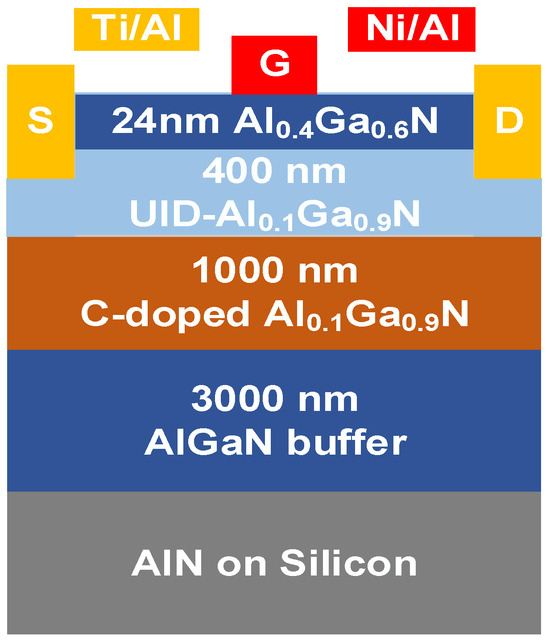
Figure 1.
The cross-sectional structure of Si-based AlGaN HEMT.
3. Results and Discussion
As shown in Figure 2a, the DC output characteristics of Si-based AlGaN HEMTs were measured at 25~200 °C with a growing step of 25 °C under a given VG of 3 V. At 25 °C, the maximum output current (ID,max) of the AlGaN HEMTs is 323.14 mA/mm, displaying a gradually decreasing trend as the temperature rises. The ID,max still maintains values of 212.04 and 189.50 mA/mm at high temperatures of 150 and 200 °C, respectively. So, the ratio RON,150 °C/RON,25 °C for the Si-based AlGaN HEMT is only 1.55 in this work, which is significantly lower than the corresponding values of commercial GaN HEMTs on silicon (the values of RON,150 °C/RON,25 °C of the GaN systems GS 66516B and GS 66502B are about 2.58). Therefore, the Si-based AlGaN HEMT demonstrates more stable output characteristics compared with GaN HEMTs at high-temperature applications [9,10].
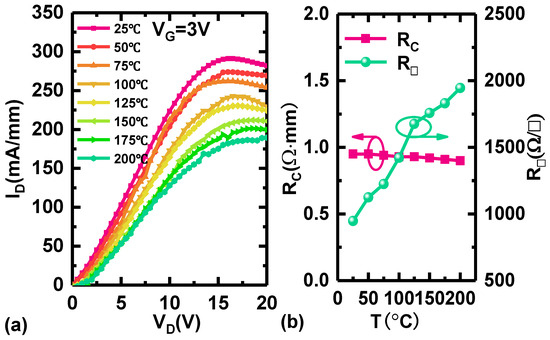
Figure 2.
(a) The output characteristics of Si-based AlGaN HEMT at 25/50/75/100/125/150/175/200 °C. (b) The variation of RC and RSH at different temperatures.
The degeneration of ID,max at high temperatures may be caused by an increase in ohmic contact resistance (RC) and 2DEG channel resistance (RCH). RON can be realized as RON = RS + RD + 2RC + RCH. RS or RD is the parasitic source/drain resistance. Usually, RS and RD are much lower than RC. As shown in Figure 2b, RC is calculated using a transmission line model (TLM) at different temperatures. The variation of RC is very poor with the growing temperature. Compared with the variation of RON, the variation of RC is negligible. However, it is observed that the sheet resistance (RSH) increases from 947.0 Ω/□ to 1945.7 Ω/□ as the temperature rises from 25 °C to 200 °C, indicating that the rise in RON can be attributed to increased channel resistance, which can be interpreted as decreased carrier mobility.
The temperature-dependent C-V characteristics of the Schottky barrier diode with an AlGaN channel are shown in Figure 3a. The electron concentration of the AlGaN channel varied with the temperature-dependent depth profiles and are derived by the following Equations (1) and (2) [26,27], and the relevant results are shown in Figure 3b:
where Z is the depth to the gate, ε is the dielectric constant of the barrier, C is the junction capacitor, and A is the area of the junction capacitor. The dielectric constant used in this work is . The n2DEG is approximately calculated by Equation (3). As shown in Figure 3c, with a temperature increase, the variation of n2DEG is very poor.
Z = εA/C
μ = 1/(RSH × ns × q)
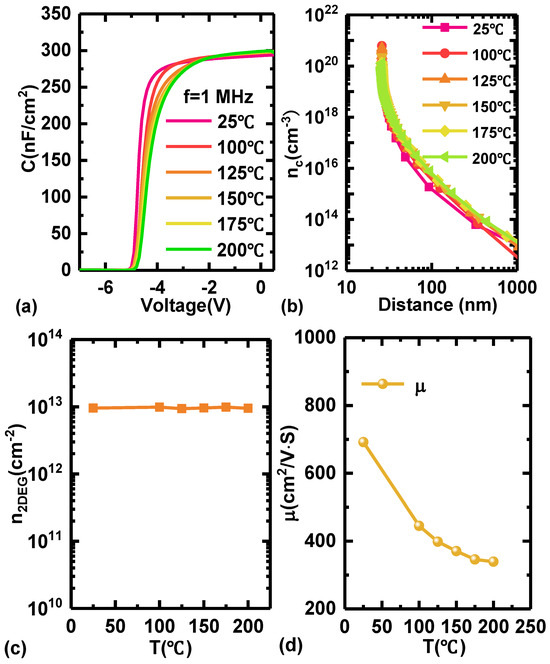
Figure 3.
(a) The temperature-dependent C-V characteristics of the Schottky barrier diode on the AlGaN channel. (b) The value of carrier concentration with the variation of channel depth. (c) The temperature-dependent 2DEG sheet density (n2DEG). (d) The variation of carrier mobility in the AlGaN channel with the increasing temperature.
As shown in Figure 3d, the carrier mobility of the AlGaN channel (μAlGaN) is approximately calculated according to Equation (4) [28], which decreases from 691.58 to 339.47 cm2/v·s as the temperature increases from 25 °C to 200 °C, and it is in good agreement with the simulation result obtained by alloy scattering-limited and optical phonon-limited mobility models [13]. As is known, the μAlGaN is affected jointly by alloy disorder scattering and optical phonon scattering, where μOP is very sensitive to temperature and alloy scattering-limited mobility (μalloy) is inverse [13]. When the temperature rises, the influence of μOP is gradually reduced while part of μalloy still remains stable, leading to the idea that the AlGaN HEMTs have very excellent output characteristics under high-temperature conditions, something which is lacking in the GaN HEMTs because μOP is very dominating in terms of carrier mobility.
Furthermore, the transfer characteristics of AlGaN HEMTs were measured at 25~200 °C with a step of 25 °C under a VD of 10 V and are shown in Figure 4a. VTH shifts slightly towards a positive direction, from −4.6 V to −4.5 V, as the temperature increases. ID,off-state also increases marginally from 2.87 × 10−5 to 1.85 × 10−4 mA/mm. Additionally, the buffer leakage current (Ibuffer) measured with an isolated active-area mesa structure is only 9.5 × 10−8 mA/mm at 200 °C, which is significantly lower than ID,off-state. Therefore, an increase in ID,off-state at high temperatures is attributed to the reverse gate leakage current, as shown in Figure 4b. And it can be suppressed by optimizing the barrier layer or adopting a metal–insulator–semiconductor (MIS) structure.
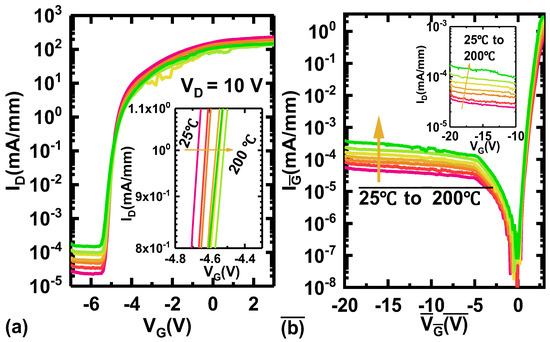
Figure 4.
(a) The transfer characteristics of Si-based AlGaN HEMTs at 25/75/100/125/150/175/200 °C with an applied VD of 10 V. (b) The forward and reverse I-V characteristics of the Schottky barrier diode in the AlGaN channel at different temperatures.
The AC capacitance technique was used to characterize the trapping effect on AlGaN HEMTs at a room temperature of 25 °C and a high temperature of 200 °C. The frequency ranged from 1 kHz to 300 kHz. As shown in Figure 5a,b, the conductance gradually increases and then decreases with the growing radial frequency. It is observed that only one conductance peak exists for a given VG at 25 °C in Figure 5a, which can be assumed as only one kind of trap state existing in the AlGaN channel. However, there are two conductance peaks occurring at 200 °C in Figure 5b, indicating that two kinds of trap states exist in the AlGaN channel under high-temperature conditions.
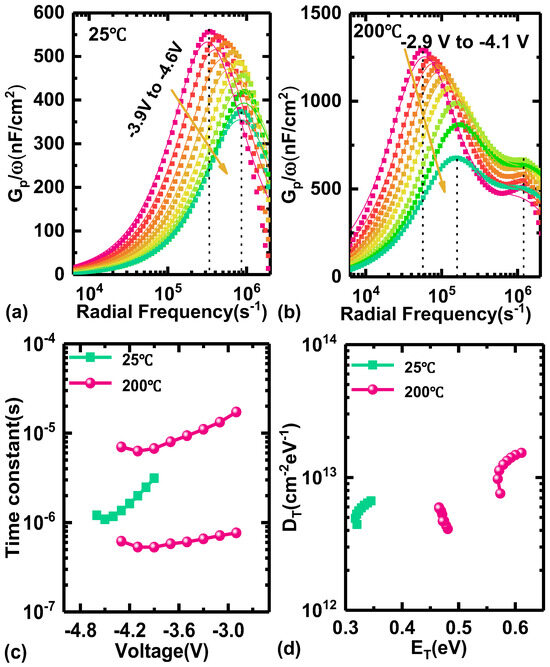
Figure 5.
Conductance as a function of radial frequency for Si-based AlGaN HEMTs at (a) 25 °C and (b) 200 °C. (c) The time constant of trap states as a function of gate voltage. (d) The trap state density as a function of their energy.
Here, the plots in Figure 5a,b are effectively fitted as these curves by the following equations, respectively:
Therefore, the time constant (τT) and trap DT can be extracted from the above equations. The relationship between τT and the applied gate voltage is depicted in Figure 5c at 25 °C and 200 °C, respectively, where τT is distributed in the range of 1.08~3.13 μs for the device working on 25 °C but two types of values of 0.53~0.77 μs and 6.29~17.2 μs for that on 200 °C, indicating the existence of two kinds of trap states at the same time. So, these states can be calculated by the equation as follows:
Here, the cross-section of the trap states () is captured as 3.4 × 10−15 cm−2, and the density of states in the conduction band (Nc) is 2.2 × 1018 cm−3. The average thermal velocity of carriers (vT) is 2.6 × 107 and 1.69 × 107 cm/s for 25 and 200 °C, respectively. As shown in Figure 5d, DT from the range of 4.43 × 1012~6.67 × 1012 cm−2 eV−1 is located at ET in a range of 0.32~0.35 eV at 25 °C. But when the temperature increases to 200 °C, DT with a distribution of 4.09 × 1012~5.95 × 1012 and 7.58 × 1012~1.53 × 1013 cm−2 eV−1 is obviously located at ET in the range of 0.46~0.48 eV and 0.57~0.61 eV, respectively. Compared with the reported trapping effects in AlGaN materials on sapphire by Zhao’s work [29], the τT and DT of trap states are much lower in the AlGaN material on silicon, indicating that the AlGaN epilayer material quality has improved significantly.
4. Conclusions
In summary, the high-temperature characteristics of the Si-based AlGaN HEMTs are studied sufficiently in this work. The carrier mobility of the AlGaN channel still remains at 339.47 cm2/v·s when the working temperature reaches 200 °C, and ID,max still reaches up to 189.50 mA/mm. Moreover, only a positive voltage drift of 0.1 V occurs, and ID,off-state increases marginally from 2.87 × 10−5 to 1.85 × 10−4 mA/mm, strongly proving the outstanding working performance of Si-based AlGaN HEMTs compared with GaN at high temperatures. Finally, the inner trapping effect in Si-based AlGaN materials is investigated using the AC capacitance technique. Two types of trap states are found at a high temperature of 200 °C. The first type of trap state has a DT ranging from 4.09 × 1012 to 5.95 × 1012 cm−2 eV−1 and is located within an ET of 0.46 to 0.48 eV. The second type of trap state has a DT ranging from 7.58 × 1012 to 1.53 × 1013 cm−2 eV−1 and is located within an ET of 0.57 to 0.61 eV. Hence, this work is very valuable for Si-based AlGaN materials as the channel for HEMTs, especially for high-temperature applications, and significantly pushes the development of ultra-wide bandgap semiconductors in power electronics.
Author Contributions
Conceptualization, Y.W. and L.Y.; investigation, Y.W., X.M. and L.Y.; resources, X.F., S.Z. and W.Z.; data curation, Y.W., X.M., X.F. and W.Z.; funding acquisition, Y.W. and X.F.; writing—original draft preparation, Y.W., X.F. and W.Z.; writing—review and editing, X.M., S.Z., J.Z. and Y.H.; supervision, Y.H.; project administration, L.Y., S.Z. and J.Z. All authors have read and agreed to the published version of the manuscript.
Funding
This research was funded by Postdoctoral Fellowship Program of CPSF (No.GZC20232055), China Postdoctoral Science Foundation (No. 2024M752521), National Natural Science Foundation of China (Grant No. 62304170 and 62374122) and Xidian University Specially Funded Project for Interdisciplinary Exploration (No. TZJH2024057).
Data Availability Statement
The original contributions presented in the study are included in the article, further inquiries can be directed to the corresponding author.
Conflicts of Interest
The authors declare no conflict of interest.
References
- Xiao, M.; Du, Z.; Xie, J.; Beam, E.; Yan, X.; Cheng, K.; Wang, H.; Cao, Y.; Zhang, Y. Lateral p-GaN/2DEG junction diodes by selective-area p-GaN trench-filling-regrowth in AlGaN/GaN. Appl. Phys. Lett. 2020, 116, 053503. [Google Scholar] [CrossRef]
- Lyu, Q.; Jiang, H.; Lau, K.M. High gain and high ultraviolet/visible rejection ratio photodetectors using p-GaN/AlGaN/GaN heterostructures grown on Si. Appl. Phys. Lett. 2020, 117, 071101. [Google Scholar] [CrossRef]
- Ruzzarin, M.; De Santi, C.; Yu, F.; Fatahilah, M.F.; Strempel, K.; Wasisto, H.S.; Waag, A.; Meneghesso, G.; Zanoni, E.; Meneghini, M. Highly stable threshold voltage in GaN nanowire FETs: The advantages of p-GaN channel/Al2O3 gate insulator. Appl. Phys. Lett. 2020, 117, 203501. [Google Scholar] [CrossRef]
- Li, B.; Yang, X.; Wang, K.; Zhu, H.; Wang, L.; Chen, W. A Compact Double-Sided Cooling 650V/30A GaN Power Module With Low Parasitic Parameters. IEEE Trans. Power Electron. 2022, 37, 426–439. [Google Scholar] [CrossRef]
- Murray, S.K.; Kachura, A.; Trescases, O. A 400 V Dual-Phase Series-Capacitor Buck Converter GaN IC with Integrated Closed-Loop Control. IEEE Trans. Power Electron. 2024, 39, 9579–9590. [Google Scholar] [CrossRef]
- Goto, K.; Nakahata, H.; Murakami, H.; Kumagai, Y. Temperature dependence of Ga2O3 growth by halide vapor phase epitaxy on sapphire and β-Ga2O3 substrates. Appl. Phys. Lett. 2020, 117, 222101. [Google Scholar] [CrossRef]
- Ren, Z.; Lv, D.; Xu, J.; Zhang, J.; Zhang, J.; Su, K.; Zhang, C.; Hao, Y. High temperature (300 °C) ALD grown Al2O3 on hydrogen terminated diamond: Band offset and electrical properties of the MOSFETs. Appl. Phys. Lett. 2020, 116, 013503. [Google Scholar] [CrossRef]
- Cho, Y.; Encomendero, J.; Ho, S.-T.; Xing, H.G.; Jena, D. N-polar GaN/AlN resonant tunneling diodes. Appl. Phys. Lett. 2020, 117, 143501. [Google Scholar] [CrossRef]
- Visalli, D.; Van Hove, M.; Derluyn, J.; Degroote, S.; Leys, M.; Cheng, K.; Germain, M.; Borghs, G. AlGaN/GaN/AlGaN Double Heterostructures on Silicon Substrates for High Breakdown Voltage Field-Effect Transistors with low On-Resistance. Jpn. J. Appl. Phys. 2009, 48, 04C101. [Google Scholar] [CrossRef]
- Freedsman, J.J.; Hamada, T.; Miyoshi, M.; Egawa, T. Al2O3/AlGaN Channel Normally-Off MOSFET on Silicon With High Breakdown Voltage. IEEE Electron. Device Lett. 2017, 38, 497–500. [Google Scholar] [CrossRef]
- Singhal, J.; Chaudhuri, R.; Hickman, A.; Protasenko, V.; Xing, H.G.; Jena, D. Toward AlGaN channel HEMTs on AlN: Polarization-induced 2DEGs in AlN/AlGaN/AlN heterostructures. APL Mater. 2022, 10, 111120. [Google Scholar] [CrossRef]
- Ji, D.; Ercan, B.; Benson, G.; Newaz, A.K.M.; Chowdhury, S. 60 A/W high voltage GaN avalanche photodiode demonstrating robust avalanche and high gain up to 525 K. Appl. Phys. Lett. 2020, 116, 211102. [Google Scholar] [CrossRef]
- Bajaj, S.; Hung, T.-H.; Akyol, F.; Nath, D.; Rajan, S. Modeling of high composition AlGaN channel high electron mobility transistors with large threshold voltage. Appl. Phys. Lett. 2014, 105, 263503. [Google Scholar] [CrossRef]
- Carey, P.H.; Ren, F.; Baca, A.G.; Klein, B.A.; Allerman, A.A.; Armstrong, A.M.; Douglas, E.A.; Kaplar, R.J.; Kotula, P.G.; Pearton, S.J. Extreme Temperature Operation of Ultra-Wide Bandgap AlGaN High Electron Mobility Transistors. IEEE Trans. Semicond. Manuf. 2019, 32, 473–477. [Google Scholar] [CrossRef]
- Carey, P.H.; Ren, F.; Baca, A.G.; Klein, B.A.; Allerman, A.A.; Armstrong, A.M.; Douglas, E.A.; Kaplar, R.J.; Kotula, P.G.; Pearton, S.J. Operation Up to 500 °C of Al0.85Ga0.15N/Al0.7Ga0.3N High Electron Mobility Transistors. IEEE J. Electron. Devices Soc. 2019, 7, 444–452. [Google Scholar] [CrossRef]
- Baca, A.G.; Armstrong, A.M.; Allerman, A.A.; Klein, B.A.; Douglas, E.A.; Sanchez, C.A.; Fortune, T.R. High Temperature Operation of Al0.45Ga0.55N/Al0.30Ga0.70N High Electron Mobility Transistors. ECS J. Solid. State Sci. Technol. 2017, 6, S3010–S3013. [Google Scholar] [CrossRef]
- Bassaler, J.; Mehta, J.; Abid, I.; Konczewicz, L.; Juillaguet, S.; Contreras, S.; Rennesson, S.; Tamariz, S.; Nemoz, M.; Semond, F.; et al. Al-Rich AlGaN Channel High Electron Mobility Transistors on Silicon: A Relevant Approach for High Temperature Stability of Electron Mobility. Adv. Electron. Mater. 2024, 2400069. [Google Scholar] [CrossRef]
- Chatterjee, B.; Lundh, J.S.; Song, Y.; Shoemaker, D.; Baca, A.G.; Kaplar, R.J.; Beechem, T.E.; Saltonstall, C.; Allerman, A.A.; Armstrong, A.M.; et al. Interdependence of Electronic and Thermal Transport in AlxGa1–xN Channel HEMTs. IEEE Electron. Device Lett. 2020, 41, 461–464. [Google Scholar] [CrossRef]
- Hatano, M.; Yafune, N.; Tokuda, H.; Yamamoto, Y.; Hashimoto, S.; Akita, K.; Kuzuhara, M. Superior DC and RF Performance of AlGaN-Channel HEMT at High Temperatures. IEICE Trans. Electron. 2012, E95.C, 1332–1336. [Google Scholar] [CrossRef]
- Li, L.; Yamaguchi, R.; Wakejima, A. Polarization engineering via InAlN/AlGaN heterostructures for demonstration of normally-off AlGaN channel field effect transistors. Appl. Phys. Lett. 2020, 117, 152108. [Google Scholar] [CrossRef]
- Li, X.; Zhang, W.; Fu, M.; Zhang, J.; Jiang, H.; Guo, Z.; Zou, Y.; Jiang, R.; Shi, Z.; Hao, Y. AlGaN channel MIS-HEMTs with a very high breakdown electric field and excellent high-temperature performance. IEICE Electron. Express 2015, 12, 20150694. [Google Scholar] [CrossRef][Green Version]
- Mollah, S.; Gaevski, M.; Hussain, K.; Mamun, A.; Chandrashekhar, M.; Simin, G.; Khan, A. Temperature characteristics of high-current UWBG enhancement and depletion mode AlGaN-channel MOSHFETs. Appl. Phys. Lett. 2020, 117, 232105. [Google Scholar] [CrossRef]
- Tokuda, H.; Hatano, M.; Yafune, N.; Hashimoto, S.; Akita, K.; Yamamoto, Y.; Kuzuhara, M. High Al Composition AlGaN-Channel High-Electron-Mobility Transistor on AlN Substrate. Appl. Phys. Express 2010, 3, 121003. [Google Scholar] [CrossRef]
- Zhang, L.; Zhang, J.-F.; Zhang, W.-H.; Zhang, T.; Xu, L.; Zhang, J.-C.; Hao, Y. Robust Performance of AlGaN-Channel Metal-Insulator-Semiconductor High-Electron-Mobility Transistors at High Temperatures. Chin. Phys. Lett. 2017, 34, 128501. [Google Scholar] [CrossRef]
- Zhang, W.; Zhang, J.; Xiao, M.; Zhang, L.; Hao, Y. High Breakdown-Voltage (>2200 V) AlGaN-Channel HEMTs With Ohmic/Schottky Hybrid Drains. IEEE J. Electron. Devices Soc. 2018, 6, 931–935. [Google Scholar] [CrossRef]
- Arulkumaran, S.; Egawa, T.; Ishikawa, H.; Jimbo, T. High-temperature effects of AlGaN/GaN high-electron-mobility transistors on sapphire and semi-insulating SiC substrates. Appl. Phys. Lett. 2002, 80, 2186–2188. [Google Scholar] [CrossRef]
- Krispin, P.; Spruytte, S.G.; Harris, J.S.; Ploog, K.H. Electrical depth profile of p-type GaAs/Ga(As, N)/GaAs heterostructures determined by capacitance–voltage measurements. J. Appl. Phys. 2000, 88, 4153–4158. [Google Scholar] [CrossRef]
- Baca, A.G.; Armstrong, A.M.; Douglas, E.A.; Sanchez, C.A.; King, M.P.; Coltrin, M.E.; Fortune, T.R.; Kaplar, R.J. An AlN/Al0.85Ga0.15N high electron mobility transistor. Appl. Phys. Lett. 2016, 109, 033509. [Google Scholar] [CrossRef]
- Zhao, S.; Zhang, K.; Ha, W.; Chen, Y.; Zhang, P.; Zhang, J.; Ma, X.; Hao, Y. Trap states in AlGaN channel high-electron-mobility transistors. Appl. Phys. Lett. 2013, 103, 212106. [Google Scholar] [CrossRef]
Disclaimer/Publisher’s Note: The statements, opinions and data contained in all publications are solely those of the individual author(s) and contributor(s) and not of MDPI and/or the editor(s). MDPI and/or the editor(s) disclaim responsibility for any injury to people or property resulting from any ideas, methods, instructions or products referred to in the content. |
© 2024 by the authors. Licensee MDPI, Basel, Switzerland. This article is an open access article distributed under the terms and conditions of the Creative Commons Attribution (CC BY) license (https://creativecommons.org/licenses/by/4.0/).